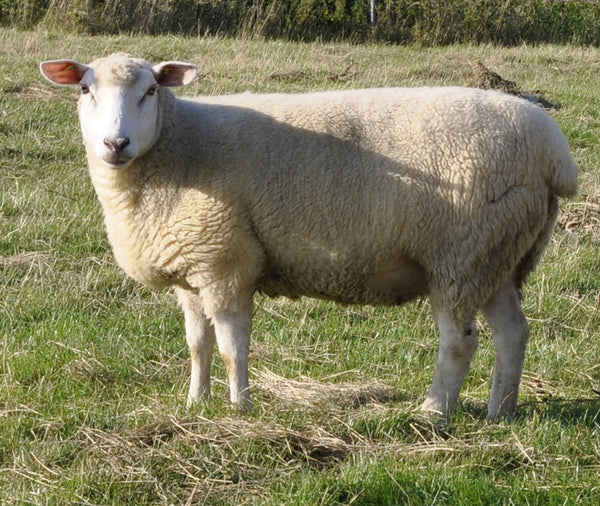Know Your Fiber: Eider Wool
Posted on June 01 2019

One of the amazing things about sheep isn’t just the wool, milk and meat they produce, it is also how they affect the surrounding environment. Now, when flocks are not well managed or are introduced to a landscape unsuitable for livestock, this can have negative consequences. Flocks need to be located on land robust enough for grazing, or else there is the risk of delicate ecosystems becoming irrevocably altered. However, humans have do have quite a knack for using some sheep traits to improve the areas they are in for the benefit of the people living there. German Whiteheaded Mutton sheep, producers of Eider wool, are some of the sheep used in this way.
German Whiteheaded Mutton were specifically developed in the mid-1800s as a dual breed wool and meat sheep that would be well suited to the wet and windy conditions of the Wilstermarsch in Germany. This area, originally marshland reclaimed by its residents from the sea by using dikes, has been fertile farmland for centuries. It is almost 12 feet below sea level, with the dikes holding back the North Sea and protecting the farmland from storm surges. Sheep of varying breeds have been a part of this German landscape for nearly as long as people have lived there, although the shepherding methods have changed over time. During the Middle Ages, sheep were allowed to graze freely on fallow fields, but this method began to change with the advent of the Industrial Revolution and increases in population. Farms became smaller and roadways became busier. Gradually, it became common practice to have sheep graze either on areas not used for growing food, such as on the dikes, or on harvested fields. Combined with a desire to have a dual-breed sheep better suited for the Wilstermarsch environment, these changes to grazing and terrain meant that new characteristics were needed.
The late 1700s had already seen a revolution in how sheep were bred, and it was these selective breeding techniques that produced the German Whiteheaded Mutton. Starting with the local Wilstermarsch sheep, a dairy sheep already well adapted to the local conditions, both British and French sheep breeds were added to the mix to produce a sheep with good quality mutton and durable wool that could be used for spinning, but that was also hardy enough to protect the sheep from coastal winds and rain they would encounter. From the British flocks they brought in English Leicester (for its long locks), Cotswold (likely for their mothering abilities, their even grazing methods, and their quality mutton), the Oxford (likely for their fine quality mutton, too), and the Hampshire (also for its quality mutton). In the 1960s and 1970s they continued to improve the breed by adding in some genetics from French flocks of Berrichon du Cher (again for its mutton, although the Berrichon du Cher’s Merino ancestry probably improved the wool, too) and Texel (for its mutton and its wool).
In addition to the goods they produce, sheep have been used by farmers and others to help manage the land. This has included carbon farming techniques to enrich the soil, natural methods of brush control, reviving native plant species and bring back native birds (see the Know Your Fiber article on Manx Loaghtan) – and, in the case of German Whiteheaded Mutton sheep, to help maintain the dikes holding back the North Sea.
German Whiteheaded Mutton can today be found grazing on the greenery of German dikes and on the stubs of harvested fields in the Wilstermarsch area. Typically moved from place to place by shepherds and sheep dogs, these sheep travel down or alongside the roads. Considered an essential part of maintaining the dikes, as German Whiteheaded Mutton graze they also stomp down the earth and fertilize the ground, encouraging new growth of the local plants that have long since adapted to being grazed upon. This process helps to stabilize the dikes, making sure they are sturdy enough to withstand the pounding wind and rains during storms. Talk about human/ovine teamwork!
The wool from German Whiteheaded Mutton is called Eider wool. Eider was originally the name of a sea duck known for its expensive and soft down that can be found in the famously warm and toasty eiderdown blankets. Why it has been applied to wool is something of a mystery, although it would not be surprising to find that naming German Whiteheaded Mutton wool Eider was the brainchild of a shepherd with marketing genius. Certainly, it is easier to say and quite descriptive of the loftiness of Eider wool. Saying “German Whiteheaded Mutton Wool” is quite a mouthful, while “Eider Wool” is short, sweet, and conjures visions of mounds and mounds of light, fluffy wool.
In fact, Eider wool is a lovely fluffy wool, although at 37-41 microns it is quite coarse compared to many other wools used for spinning. What makes this wool special is its crimp – while most wools with this micron range can be difficult to spin due to poor crimp, Eider wool has an excellent crimp that holds quite well when spinning. If you are looking for a wonderfully durable wool for outerwear, blankets, or handwoven rugs, Eider wool is the wool for you.
Interested in spinning up some Eider wool for your next project? Check out our Eider top along with all our other single-breed and blended fibers!
Photo by Anton Hornbläser [CC BY-SA 3.0 (https://creativecommons.org/licenses/by-sa/3.0)]

Follow US